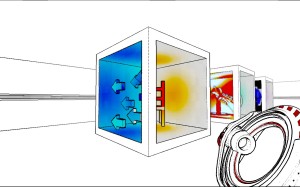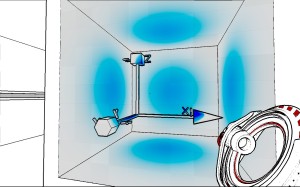While my previous post dealt with my feelings on the book as a whole, this one is more to do with one topic: perspective. It is, as Brooke mentions, paramount to understanding the situation of how users interact with virtual environments; they are projected into a three-dimension space as positioned on a flat plane. The extra dimension (the perceived one) is nothing more than a visual illusion, one crafted to suggest a depth that is not actually “there” for the user.
This also gets at the “ideal of transparency” Brooke summarizes from the writings of Lanhom on print (132). The typed words on the page create a distance between the reader and itself. In the terms of Brooke, the text is looked at, it is the subject of a user’s gaze. However, within a digital settings, as I mention in the other post too, the positioning changes. The user is the subject of perspective.
Instead of merely words on a page, the user can cross the print event horizon and change its font and placement; the text is both static and dynamic simultaneously. As Brooke quotes from Bolter and Gromala, the perspective has the “states of transparency and reflexivity” (132). The user sees through, to employ another Brooke term, the window to another while also looking at the text itself. The information is superimposed and juxtaposed at the same time.
This also creates, in turn, the subjectivity of the user as a reflection of their interactions. The term Brooke uses here is from which to situate the user as within the prism of the perspective itself. The reflexivity of the feedback loop keys the user into interactions that both create the depth of context (as a function of the perspective) and trap the user as existing within the intersection of their point of view and that of the screen itself. The perspective exists because of the user; the materiality of the user grounds the perception as coming from a body.
Comments:
Sarah Carter’s “Week 5: Sept 22nd Notes #4” (Comment)
I liked the videos highlighting the different ‘p’s covered in the reading. Even though I don’t really know Stanley Kubrick works super well, it was cool to see how one-point perspective has played such a significant role in his films.
Sarah Camp’s “Week 5 – 3D Game Labs and Lingua Fracta” (Comment)
The reminder about the spread — and reinterpretation — of ideas and memes between subculture groups was interesting. How situated certain concepts can be is a great point about the various groups that inhabit various parts of forums and blogs too. Discourse communities often collide.


I loved this sentence from your notes: “The reflexivity of the feedback loop keys the user into interactions that both create the depth of context (as a function of the perspective) and trap the user as existing within the intersection of their point of view and that of the screen itself.” The terms at, through, and from which really changed how I thought about the way we engage with new media. Thinking about this rhetorically, the presentation, design, and construction of a text could impact the users interpretation and engagement.